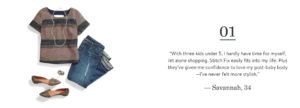Stitch Fix Uses Big Data to Personalize Shopping

A 2014 OnePoll survey showed that women spend more than 190 hours shopping for clothes and shoes annually.1 What if we could reallocate that time and leave our fashion choices up to an online personal shopping site? With a team of 80 data scientists (including astrophysicists, computational neurologists, and 49 Ph.Ds), Stitch Fix has found a way to employ machine learning to pick out our clothes better than we can.2 Gone are the days when we have to spend countless hours trying on dresses to wear for that interview. Now we can rely on Stitch Fix to get it right.

What is Stitch Fix?
Stitch Fix, a San Francisco based online startup, was founded by HBS graduate Katrina Lake in 2011. The service partners data science with a team of 300 human stylists to provide women a personalized collection of boutique-brand clothes, shoes, and, accessories. When clients sign up for the service, they are asked to fill out a 10-minute survey that aggregates information on 50 data points including their size, location, body type, and fabric, color, and pattern preferences. The program can even read images in the client’s Pinterest profile to better understand her style when she cannot articulate it into words.3
The machine learning algorithm uses this data to curate a package of 5 items to send to the customer. The customer pays a $20 “styling fee” and tries on the clothes at home, keeps what she wants and returns what she doesn’t want. She pays the retail price of the clothes she keeps and the $20 is applied as a credit to her purchase.5 The program then uses this feedback to compile an even better set of items for her next fix.2 Stitch Fix partners with 200 labels and brands and has created a private label line for basics.4
Wow, but does it actually work?
It looks like Stitch Fix is actually getting it right. 80% of people who order a box order a second box within 90 days. Furthermore, Forbes estimates that Stitch Fix brought in $250 million of revenue and was profitable in 2015; this sales number is predicted in increase by 50% in 2016.2
Oppositely, established retailers like Nordstrom and Gap continue to face losses due to increased ecommerce competition. Stitch Fix founder, Katrina Lake, believes that in-store conversion is low because customers do not have the hands on help of staff who know their size or preferences. Oppositely, Stitch Fix can use all of your data to ensure you never leave a box empty handed.
Future Recommendations for Stitch Fix
While Stitch Fix has found a way to democratize the VIP treatment of personal shopping, there are many more opportunities to grow with their data analytics. Industry analyst Jeff Kagen acknowledges that there is room for improvement: “I think this is just the beginning, many new business models will form with A.I. as the center of their universe… This is the Model T for the A.I. revolution.”3
Eric Colson, Chief Algorithms Officer at Stitch Fix and the former VP of Data Science at Netflix acknowledges the power of their programing: “The clothes are not exclusive. We don’t price them better than anyone else. We don’t do fast shipping. We’ve just got to be more relevant.”2 However, as data-driven personalization becomes more prevalent in ecommerce, Stitch Fix needs to offer these perks and focus on a more streamlined, customer service-centric experience to be competitive. Moreover, they have opportunity to use their sales data to improve their private label product offering to provide exactly what their customers want.
Additionally, there is an opportunity to utilize their data to improve the in-store shopping experience. Rather than shipping boxes, customers could have the option to go to a store to try on their curated package of items. Data-driven associates could immediately provide additional product recommendations and replace items that initially did not work out due to style or fit. If Stitch Fix doesn’t want to enter the brick and mortar retail business, they could sell the algorithm to a big box retailer who would benefit from the customer data in store and online.
Finally, there is an opportunity for Stitch Fix to curate specialized packages for formal events and special occasions. Rent the Runway is set to hit $100mil in revenues in 2016 by providing customers with a convenient way to find special occasion dresses.6 However, searching for styles on their website is cumbersome and their customer data is not personalized. Stitch Fix could increase incremental revenue by providing customers with specialized boxes for various formal events. Further, they could create a line of special boxes for occasions like job interviews, birthdays, or pregnancies. These could make great gifts and help current Stitch Fix lovers spread the word to potential new customers in a fun way.
(799 Words)
Footnotes
- Johnson, Emma. “The Real Cost of Your Shopping Habits,” Forbes, January 15, 2015, http://www.forbes.com/sites/emmajohnson/2015/01/15/the-real-cost-of-your-shopping-habits/#702eb2e321ae, accessed November 16, 2016.
- Mac, Ryan. “Stitch Fix: The $250 Million Start Up Playing Moneyball,” Forbes, June 1, 2016, http://www.forbes.com/sites/ryanmac/2016/06/01/fashionista-moneyball-stitch-fix-katrina-lake/#1b6b1a2e2eac, accessed November 16, 2016.
- Gaudin, Sharon, “At Stitch Fix, Data Scientists and A.I. Become Personal Stylists,” Computerworld, May 6, 2016, http://www.computerworld.com/article/3067264/artificial-intelligence/at-stitch-fix-data-scientists-and-ai-become-personal-stylists.html , accessed November 16, 2016.
- Hull, Dana. “Q&A: Stitch Fix founder Katrina Lake, on melding fashion and technology,” The Mercury News, March 14, 2014, http://www.mercurynews.com/2014/03/14/qa-stitch-fix-founder-katrina-lake-on-melding-fashion-and-technology/, accessed November 16, 2016.
- Stitch Fix, “Women,” https://www.stitchfix.com/women, accessed November 16, 2016.
- O’Connor, Clare. “Rent the Runway to hit $100M Revenues in 2016 Thanks to Unlimited Service,” Forbes, June 15, 2016, http://www.forbes.com/sites/clareoconnor/2016/06/15/rent-the-runway-unlimited-women-founders-revenues/#e4c060d49e4f, accessed November 16, 2016.








Kat,
I’ve been intrigued by Stitch Fix for some time, and even gave my Mom a subscription as a birthday gift a couple of years ago. I think you did a terrific job of calling out some of the opportunities for the company — they’ve done a great job curating items based off of style and size preferences, but their overall delivery and pricing system has vast opportunity for improvement. I’d like to add one more thing for Stitch Fix to consider — how do the curate pricing appropriately for an individual? Short of that, how can they use pricing to encourage people to buy more in each box (I guess I have pricing on my mind this week!). I read about a company calledEditd (http://fortune.com/2014/09/22/fashion-industry-big-data-analytics/), which puts the power of data in the hands of consumers to help them find the best deals for items they’d like to buy. Could we put the data Editd has into the hands of Stitch Fix’s data scientists to help expand the value Stitch Fix provides? Right now their client base is just the less price-sensitive “Subscription Sallys (or Sams)” and could it eventually also include the “Bargain Betty (or Bills).”
I think StitchFix is one of the most interesting eCommerce companies to study. While the company looks to serve fashion lovers looking for their “Fix,” they’ve found a high portion of the demand for their brand isn’t coming from fashionistas at all. The company has found tremendous success styling women who either a) don’t enjoy shopping b) don’t feel like they know what to pick out c) don’t have access to the stores/styles they want based on where they live or d) don’t feel confident in themselves and feel more comfortable trying things on at home. The company claims the magic sauce is their algorithm that matches people with the right items, but in reality the company relies of thousand of remote pay-by-the-hour employees who rarely, if ever, see the clothes in person and “shop” for each customer virtually, choosing items from available inventory online and writing personalized notes and styling recommendations. In a way, this model is returning to the original retail model, with retailers paying stylists to give personalized styling services to customers. Will StitchFix ever be able to rely on the algorithm? Do customers enjoy the personalized touch that stylists give and cannot be recreated by a computer? It will be interesting to see how much the retailer will be able to use technology to bring down employee costs as they scale.
I think it’s mind-blowing to hear the 80% reorder stats. Given that almost all of the national fashion retailers get the recommendations completely off the mark or too broad, it makes me want to try the service out. I think another opportunity for this company is to target men. The barrier would be to get men to order it in the first place, but I think men are less sensitive to taste (hopefully doesn’t sound biased). If the company is able to offer a pretty standard box with basic style (e.g. sweaters with no patterns, lightly-printed shirts), I think men might score a higher reorder rate than women who have a more variety of taste when it comes to fashion or dressing up for special occasions.
Building on Cara McCutcheon’s point above, I want to ask if you think there’s an opportunity for Stitch Fix to be a liquidation channel for a lot of retailers. Since Stitch Fix has consumer data, chances are they can take in out-of-season stock from retailers that is just sitting in their inventory and sell them at a slightly discounted price to customers. You’re reducing warehousing and inventory cost for the retailers while being able to provide better value for customers.
Another point I want to make is that Stitch Fix would need to be cautious about creating private label clothes. In Southeast Asia, a fashion ecommerce retailer called Zalora started manufacturing private label clothes that are basically cheaper versions of successful fashion styles from other retailers. The retail partners weren’t very happy with that since Zalora undercuts their price and takes away their market share.
What an awesome post KatFranklin! I really enjoyed learning more about what Katrina Lake is doing at StitchFix. You’re familiar with my interest in applying data science to style, so I appreciated the chance to read about how StitchFix is collecting data on its customers and analyzing it to make recommendations. Over the course of some of my conversations with women about their style decisions, StitchFix (along with other ‘style-in-a-box’ concepts such as LeTote and to an extent, RtR) often came up as a product offering that was popular and familiar. One concern that surfaced across a couple of customers was the quality of StitchFix’s clothing. Many said that the quality of the clothing sent declined over time, which ultimately drove them to cancel their subscription. I have not tried StitchFix before, but am curious about their inventory and its brand composition. I’m curious if StitchFix would consider expanding its business model to allow its users to have more control over the items in their box. Specifically, the company could still apply a big data approach to recommending items to its users, but ultimately allow the user to pick-and-choose what they receive.
I also found the 190 hours statistic you cited to be staggering! However, I question whether or not people truly want to decrease that amount… to a certain degree, mindlessly browsing through online stores is therapeutic in a similar way that television can be. For this market of people (and I wonder how its size compares to StitchFix’s current target market, which TomCat did an excellent job of describing), I think the key business opportunity is not to decrease the amount of time they spend online browsing, but more so to find a way to make that online browsing convert into sales.